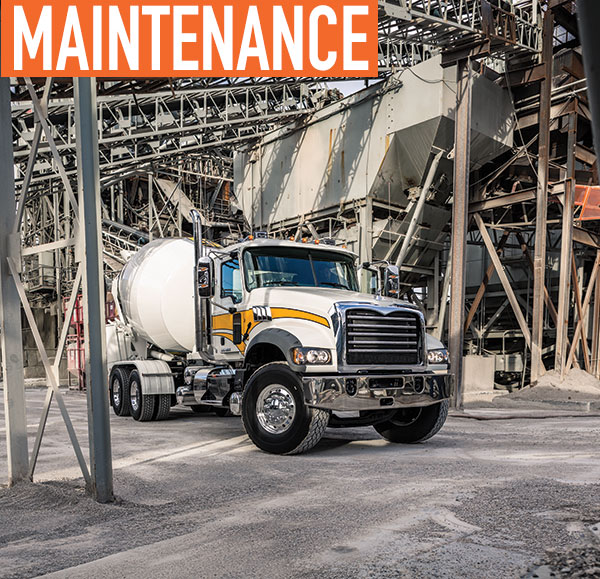In a recent conversation about extending time between oil changes, a representative from a large truck manufacturer mentioned that one of their biggest concerns was that extended service intervals for engine oil could negatively affect the overall maintenance of the truck.
PERFECTING SCHEDULES
If you have determined that a longer drain interval fits into your operational goals and maintenance strategy, you should start giving more attention to the scheduling of other truck maintenance. The list of every maintenance task that takes place in a professionally managed truck fleet is extensive, and the frequency of each can vary. The best practices observed in larger fleets suggest using checklists during the following events:
- Daily walk around
- Fueling stops
- Inspection/return to home/shop
- Weekly or monthly service
- Oil change/drain intervals (A, B, C…)
The Technical and Maintenance Counsel (TMC) for the American Trucking Associations (ATA) lists more than 120 checkpoints in its Preventive Maintenance Inspection (PMI) Manual. Its SuperTech competition can be an eye-opening experience if you aren’t involved in the day-to-day maintenance of commercial trucks. In the PM station of the contest, technicians are handed a brief description of tasks to complete, but judges are scoring on a much more detailed checklist to evaluate each technician’s performance. Not all items in the PMI Manual are performed at the time of an oil change. The point of the discussion is to consider the maintenance tasks that are scheduled around oil change intervals and the implications of changing these schedules.
The primary question: What are some of those items, and can their service frequency be extended along with your newer, longer, oil drain interval? If not, what are your options? For simplicity, let’s look at a theoretical example from a Class 8 truck. We will use some round numbers to make the math simpler:
Clessie was changing his oil every 45,000 miles, based on an engine manufacturer endorsement. He was in the habit of greasing his steering linkages and other chassis points every 15,000 miles (⅓ of a drain interval). Since his gear oil service interval could be up to 150,000 miles, he would schedule it at every third oil drain (135,000 miles). He could have chosen to wait until the next stop for greasing the truck (three ⅓ oil drains, 150,000 miles), but that could be an administrative burden tracking those intervals.

With his new 2017 15-liter engine and endorsed CK-4 engine oil, he is now allowed to drain his engine oil at 60,000 mile intervals:
- Does he perform his greasing service at 15,000 miles (¼ of drain interval)?
- Does he change gear oil at 135,000 miles, or maybe 150,000?
- Perhaps he should change his gear oil at 120,000 or maybe 180,000? It may be worth considering every 240,000 or even 480,000 miles.
- Finally, he could continue to change the oil every 45,000 miles (or 50,000 or 55,000).
You can start to see how several things will need to be considered, including your middle school math skills. For the sake of further discussion, let’s focus on the general maintenance involving lubricants and coolants. The good news is, you have some options.

We spoke earlier about your operational goals and maintenance strategy. It may have evolved through decades of experience or derived from a textbook approach to maintenance best practices. Even within a given segment of the fleet industry—construction equipment, local delivery, refuse, highway construction, aggregate, etc.—we see some variation of priorities when it comes to goals:
- Fuel consumption (efficiency/cost)
- Overall operational cost
- Technician shortage/constraints
- Maintenance facility constraints
- Product consolidation
- Cost of maintenance materials (lubricant cost)
- Reliability/downtime/unexpected repairs
- Warranty compliance and product approvals
Part of what lubricant providers must do is to provide customers with options that are in line with their priorities.
Greases: Of all the fluids and lubes used, greases are one of the least controlled by OEM requirement or specification. Work with your HD lubricant representative and compare the latest products offered for extended protection. In some cases, this may reduce the number of times you have to touch the truck and enable you to sync your service schedule.
Transmission fluid: Whether you run automatic or manual transmissions, the fluids tend to be spec-driven. Transmission OEMs will have specifications for what fluids can be used. You may find, however, that there are multiple approved/allowable specifications for the same transmission. Service intervals may be dependent upon which spec/fluid you choose. Typically, approvals for longer drain intervals will go along with the more expensive fluids and it is often an overall savings to use these products.

Gear oil: The situation with gear oil and transmission fluids is very similar. Most every OEM has its own gear oil specifications, as well as multiple options. If you purchase a fluid approved to spec “A,” you may be approved for 100,000 miles, where if you choose “B,” “C,” or “D” you could extend your drains up to 500,000 miles.
Anti-freeze/coolants: The good news is that most heavy-duty coolants are formulated to work for hundreds of thousands of miles if you keep the system topped off. The caution, however, is that not all coolants play well together. While the product line might include multiple products that meet the manufacturer’s requirements/specifications, those products may not be fully compatible with each other. Working with your coolant supplier, you can make an informed decision as to what product will help you meet your goals. It’s in our best interest to help you understand which products will require a flush and fill, as opposed to topping off the system with compatible products.
Engine oils: The API CK-4 products will be the basis of your engine oil selection, but there will be differences depending upon your engine OEM and the oil you choose. Each major engine manufacturer will have its own specification that typically requires all the API tests with one or more additional requirements. The service intervals are primarily based upon the fuel mileage, which indicates a lot about how you use your truck(s). For vocational and off-highway use, the drain interval may be dictated in hours.
WATCH YOUR LEVELS
Many of the newer specifications for products include lower viscosities for improved fuel efficiency. Even when looking at transmission fluids and gear oils, it is worth noting that lower viscosities provide some level of fuel efficiency, but typically require more advanced additives to offer the protection needed for heavy-duty applications. Though you may be moving to longer service intervals and fewer “touches,” it remains crucial that fluid levels are monitored and topped off, as needed.
ABOUT THE AUTHOR:
Michael Wedding is a mechanical engineer and lubricant specialist with a focus on heavy-duty equipment applications. He serves as the manager of Valvoline’s Engineering and Technical Services department and is an avid automotive racing enthusiast. Find out more about Valvoline Heavy Duty products at www.valvolinehd.com.
_______________________________________________________________________
MODERN WORKTRUCK SOLUTIONS: JULY 2017 ISSUE
Did you enjoy this article?
Subscribe to the FREE Digital Edition of Modern WorkTruck Solutions magazine.
![]()




